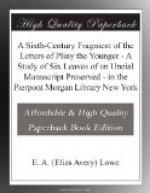A study of our collation will also show some forty cases of correction in _{Pi}_ by either the scribe himself or a second and possibly a third ancient hand. Here Aldus, if he read the pages of our fragment and read them with care, might have seen warrant for following either the original text or the emended form, as he preferred. The most important cases are: 61, 14 sera] _{Pi}a_ SERUA _{Pi}{2}_ 61, 21 considit] _{Pi}_ CONSIDET _{Pi}{2}a_ The original reading of _{Pi}_ is clearly CONSIDIT. The second I has been altered to a capital E, which of course is not the proper form for uncial. 62, 5 residit] _{Pi}_ residet a Here _{Pi}_ is not corrected, but Aldus may have thought that the preceding case of CONSIDET (m. 2) supported what he supposed the better form residet. 63, 11 posset] a POSSIT (in posset m. 1?) _{Pi}_ Again the corrected E is capital, not uncial, but Aldus would have had no hesitation in adopting the reading of the second hand. 64, 2 modica vel etiam] a MODICA EST ETIAM (corr. m. 2) _{Pi}_ 64, 28 excurrissem accepto, ut praefectus aerari, commeatu] a Here _{Pi}_ omitted accepto ut praefectus aerari,—evidently a line of the manuscript that he was copying, for there are no similar endings to account otherwise for the omission. 66, 2 dissentientis] a ex DISSITIENTIS m. 1 (?) _{Pi}_.
There are also a few careless errors of the first hand, uncorrected, in _{Pi}_, which Aldus himself might easily have corrected or have found the right reading already in the early editions. 62, 23 conteror quorum] a CONTEROR QUI HORUM _{Pi} B F_ 63, 28 si] a SIBI _{Pi}_ 64, 24 conprobasse] COMPROUASSE _{Pi}_.
In view of these certain errors of the first hand of _{Pi}_, most of them corrected but a few not, Aldus may have felt justified in abiding by one of the early editions in the following three cases, where _{Pi}_ might well have seemed to him wrong; in one of them (64,3) modern editors agree with him: 62, 20 aurium oculorum vigor] {Pi} aurium oculorumque uigor a 64, 3 proferenda] a CONFERANDA {Pi} 65, 11 et alii] {Pi} etiam alii a.




